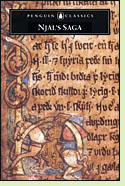Njal's Saga
Anonymous
Reviewed by David Maclaine

Njal’s Saga was the first Icelandic saga I heard of, thanks to a Monty Python episode which offered scenes from a purported adaptation, always quickly broken off by the report: “We now interrupt Njal’s Saga.” As it happens, the saga offers a lot more entertainment than was suggested by those brief scenes of a shaggy-bearded comedian climbing onto a pony. It is one of the longest and richest of the genre, a tale of slow-simmering family feuds, kept going by the dogged persistence of wives until the patient men who keep striving for peace run out of resources. It offers a pair of contrasting heroes, one an outstanding warrior, the other a man of keen legal skill, and both come at last to dramatic ends. But the death of the man known to Icelandic tradition as Burnt Njal does not end the tale, which continues until the fate of all his enemies has been told. For some of them the trail leads to the battle of Clontarf, and the saga provides a vivid look at that famous Pyrric victory.
In the course of the saga, the reader follows vivid personalities through decades of conflict. There are ambushes and fierce hand to hand fights on land, sea and ice, but also more peacefully resolved contentions, including lawsuits and monetary settlements, which show us that Icelandic law was less likely than that of Texas or Florida to offer a free pass on a claim of self-defense. There are dreams and eerie visions, a bloody cloak brandished to invoke revenge, and more than a few men who foresee their fates and face them with stoic calm. The style of Njal’s Saga is the usual proto-Hemingway prose favored by the Icelandic storytellers, with direct description, short sentences and a minimum of troubled introspection. Written by an unknown author around the year 1280, the saga deserves its long-lasting popularity. (circa 1270 to 1290; 400 pages in the 2006 Dover edition)
More about Njal's Saga at Powell's Books or Amazon.comNjal's Saga appears on the list of The 45 Best Historical Novels Set in the Viking Age
Other Icelandic sagas:
The Saga of Gunnlaug Serpent-Tongue (circa 1300; author unknown), about a tenth-century Icelandic skald (poet), his rivalry with another skald, and his loss of the woman he loves. Read online at the Icelandic Saga Database; also included in The Sagas of Icelanders, edited by Jane Smiley
The Saga of the People of Laxardal (13th century; author unknown), about Ketill Flatnose and his descendants, especially his daughter Unn the Deep-Minded. See review or read online at the Icelandic Saga Database. This saga is also included in The Sagas of Icelanders, edited by Jane Smiley
Gisli Sursson's Saga (late 13th or early 14th century; author unknown), about a migrant from Norway to Iceland and the tragic fate that entangles him, his brother, and his two brothers-in-law. Read online at the Icelandic Saga Database; also included in The Sagas of Icelanders, edited by Jane Smiley
Nonfiction about Viking-Age Iceland:
Iceland: Land of the Sagas by David Roberts with photography by Jon Krakauer (1990), about the authors' travels in Iceland and the history of Iceland, especially the period when the Viking-Age sagas were written. More info
Viking-Age Iceland by Jesse L. Byock (2001). More info
Icelanders in the Viking Age: The People of the Sagas by William R. Short (2010). More info
Online:
Njáls Saga trailer, for the Icelandic movie
Njorl's Saga (Part II) by Monty Python at YouTube
Back to Novels of Scandinavia and the Vikings
Back to Directory of Book Reviews